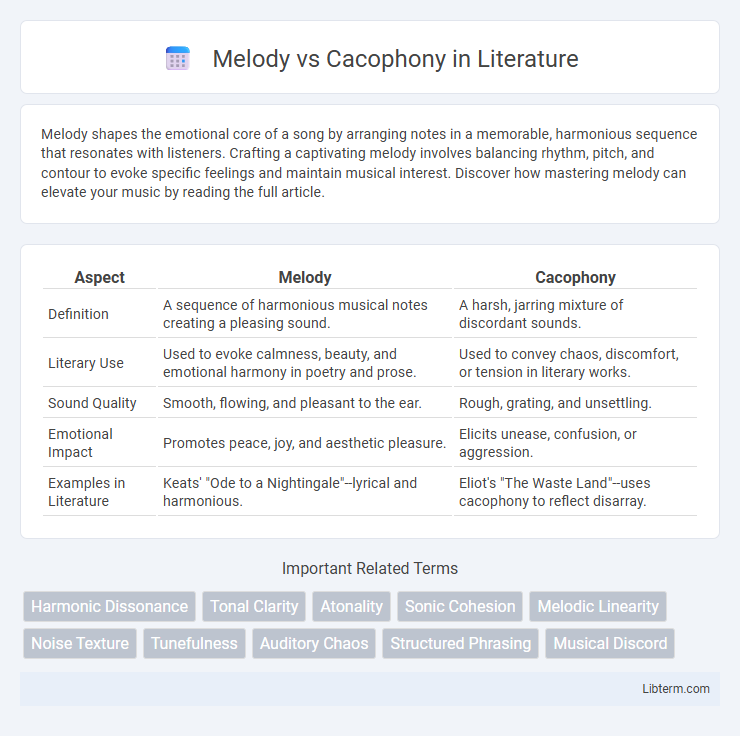Melody shapes the emotional core of a song by arranging notes in a memorable, harmonious sequence that resonates with listeners. Crafting a captivating melody involves balancing rhythm, pitch, and contour to evoke specific feelings and maintain musical interest. Discover how mastering melody can elevate your music by reading the full article.
Table of Comparison
| Aspect | Melody | Cacophony |
|---|---|---|
| Definition | A sequence of harmonious musical notes creating a pleasing sound. | A harsh, jarring mixture of discordant sounds. |
| Literary Use | Used to evoke calmness, beauty, and emotional harmony in poetry and prose. | Used to convey chaos, discomfort, or tension in literary works. |
| Sound Quality | Smooth, flowing, and pleasant to the ear. | Rough, grating, and unsettling. |
| Emotional Impact | Promotes peace, joy, and aesthetic pleasure. | Elicits unease, confusion, or aggression. |
| Examples in Literature | Keats' "Ode to a Nightingale"--lyrical and harmonious. | Eliot's "The Waste Land"--uses cacophony to reflect disarray. |
Understanding Melody: The Art of Musical Harmony
Melody is the artful arrangement of individual musical tones that create a cohesive and pleasing sequence, forming the foundation of musical harmony. It involves pitch, rhythm, and dynamics working together to evoke emotion and convey a musical narrative. Understanding melody enhances the appreciation of how harmonious sound contrasts with cacophony, which consists of dissonant and jarring noises.
Defining Cacophony: The Sound of Discord
Cacophony is defined as a harsh, discordant mixture of sounds that disrupts auditory harmony and creates an unsettling listening experience. It often involves clashing tones, jarring rhythms, and uncoordinated noise that contrasts sharply with melodic sequences. This sonic discord embodies chaos and tension, commonly used in literature and music to evoke discomfort or heightened emotional intensity.
Historical Perspectives: Melody and Cacophony in Music
Throughout history, melody has been the cornerstone of musical expression, emphasizing harmonious sequences of tones that convey emotion and structure, as seen in classical compositions from Beethoven to Mozart. In contrast, cacophony emerged prominently in 20th-century avant-garde and experimental music, challenging traditional harmonic principles with dissonance and noise exemplified by composers like John Cage and Arnold Schoenberg. The evolving interplay between melody and cacophony reflects cultural shifts and innovations in musical aesthetics, influencing genres from Romanticism to modern electronic soundscapes.
Emotional Impact: How Melody and Cacophony Affect Listeners
Melody creates an emotional connection by using harmonious tones and predictable patterns that evoke feelings of joy, nostalgia, or calmness. Cacophony generates tension and discomfort through dissonant sounds and irregular rhythms, often eliciting anxiety or unease. Listeners respond to melody with relaxation and emotional resonance, while cacophony provokes alertness and heightened sensory awareness.
Melody in Popular and Classical Music
Melody in popular and classical music serves as the primary element that captures listeners' attention, characterized by a coherent sequence of musical notes forming a pleasing tune. In popular music, melodies often rely on simple, repetitive structures and memorable hooks to enhance singability and mass appeal, while classical melodies display greater complexity, evolving through intricate phrasing and thematic development. Both genres utilize melody to evoke emotion and create identity, but classical compositions typically emphasize melodic variation and development, contrasting with the more immediate and accessible melodic lines found in popular songs.
Cacophony in Avant-Garde and Experimental Genres
Cacophony in avant-garde and experimental genres serves as a deliberate dissonance challenging traditional melodic structures, pushing the boundaries of auditory perception. Composers like John Cage and Luigi Russolo utilize noise and unconventional sound combinations to evoke emotional and intellectual responses beyond harmony. This sonic chaos redefines musical experience, emphasizing texture and timbre over melody to explore new artistic frontiers.
Techniques for Creating Melody
Techniques for creating melody involve the strategic use of pitch, rhythm, and phrasing to craft a tuneful and memorable sequence of notes. Employing scales, motifs, and thematic development enhances melodic coherence and emotional impact. Contrasting this, cacophony lacks structured pitch and rhythm, resulting in dissonance and auditory chaos rather than a harmonious melodic line.
Embracing Cacophony: When Noise Becomes Music
Embracing cacophony transforms dissonant sounds into dynamic musical expressions that challenge traditional perceptions of harmony, enriching auditory experiences. Modern composers and experimental musicians use cacophony intentionally to evoke emotional complexity and represent chaotic realities. This approach highlights the aesthetic value of noise, blurring boundaries between melody and disorder in contemporary music.
Melody vs Cacophony: Applications in Modern Composition
Melody provides a structured and harmonious sequence of notes that guides listeners through a piece, creating emotional engagement and memorability, whereas cacophony introduces deliberate dissonance and noise to evoke tension, chaos, or unresolved conflict. In modern composition, composers employ melody to establish motifs and themes, while strategically using cacophony to disrupt expectations, emphasize drama, or reflect complex, contemporary soundscapes. The interplay between melody and cacophony enhances dynamic contrast, allowing composers to explore a broader emotional and auditory spectrum.
Balancing Harmony and Chaos: Finding Musical Expression
Melody weaves a coherent sequence of musical notes that evoke emotional resonance and structure within a composition. Cacophony introduces dissonant sounds and irregular rhythms that challenge the listener's expectations and create tension. Balancing harmony and chaos involves blending melodic phrases with controlled discord to achieve dynamic musical expression and maintain listener engagement.
Melody Infographic

 libterm.com
libterm.com